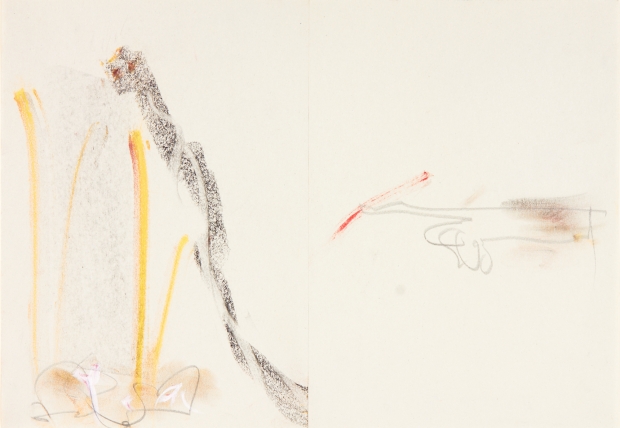
This exhibition brings together a selection of works that spans the artist’s over fifty-year long career, and includes manipulated paper reliefs, sculptures and drawings, as well as photographs of the young artist and his sculptural works taken by his life partner Antoni Bernad. As the art historian and curator Luis Pérez Oramas writes in the exhibition text, Llena’s practice has been deeply informed by his early adulthood years spent as a novice at a Capuchin convent in Sarrià, Catalonia. Similar to other Franciscan orders, the Capuchins practice austerity and discipline: they are forbidden to own property, must wear a simple brown wool tunic, spend two hours daily in private prayer and work in service of the poor. This lifestyle based on, and guided by simplicity and non-covetousness, inspired Llena to create art along these same lines, to practice a dispossession, a stripping down, of materials to their barest, most essential form – which, at times included his own body – and sourcing that which had previously been discarded. Pérez Oramas writes, “There is in his work, then, a theology of vanishing, atheist or negative: a Franciscan aesthetic of dispossession, of seeking to be nothing, with its consequent glorification of what we insistently disdain: the remains and ruins of the day [… and] ultimately, the sumptuous glory of the fragility that can be in all things: being nothing in order to become everything, as a verse by Murilo Mendes states.”
Antoni Llena (Barcelona, 1942) is a painter, writer and sculptor known for his arte povera style work. Llena was a novice in Sarrià until 1966, following the Capuchin Franciscan Order. Soon after, he became close with painters Antoni Tàpies and Albert Ràfols-Casamada. He also befriended other artists like Jordi Galí, Àngel Jové, Silvia Gubern and Alberto Porta with whom he collaborated on the first piece of video art made in Spain called Primera muerte (1969). His first solo show was at the Petite Galerie de Lleida, Catalonia in 1969, an exhibition where he drew on gallery walls and featured paper and shadow sculptures. 1969 was a turbulent year for Llena that was marked by the loss of many of his works, resulting in him vowing to take a 10-year break from art in the name of poetic radicalism. Following his return to art making, his work has also been shown at Fundació Joan Miró, Barcelona (1989, 2010); Artgrafic, Barcelona (1991); Centre Cultural La Mercè, Girona (2003); Galeria Toni Tàpies (1997, 1999, 2001, 2006) and Galería A34, Barcelona (2012, 2015, 2018). Llena’s works are held in the collections of Museu d’Art Contemporani, Barcelona; Museo Nacional Centro de Arte Reina Sofía, Madrid and the Museum of Modern Art, New York. His sculptures have also been installed in multiple public spaces across Barcelona. He was a professor at Universitat de Gerona in Catalonia where he taught artistic literature. He has also hosted workshops for the School of Visual Arts in New York and the EINA School of Art and Design in Barcelona. The artist lives and works in Barcelona.
Henrique Faria | New York. 35 East 67th St. 4th Floor. New York, New York 10065
Image: Antoni Llena. Untitled, 2018. From the series Sèrie SOS: senyals de fum des d’un subsòl, Julio 2018. Mixed media on paper. 100 drawings, 10 x 14 5/8 in. (25.4 x 37.1 cm) each
